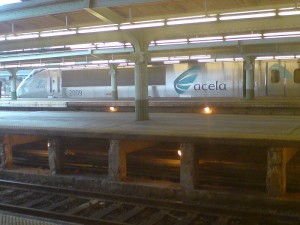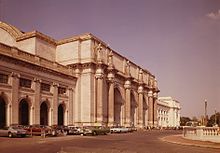Union Station (Washington, D.C.)
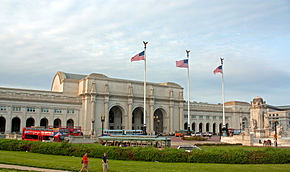
The secret below Grand Central Station
Go underground to New York’s secret rail platform under Grand Central Station – Track 61. It does not appear on any station maps or plans and was built specially for President Franklin Delano Roosevelt to use in the 1930’s. FDR had polio and used the hidden platform to get on and off vehicles without revealing his disability to the public. Heather Alexander took a tour. Published on BBC NEWS (12/16/2009), Reporter: Heather Alexander, Shot & Edited: Ramón J. Goñi
 Washington Union Station is a train station and leisure destination visited by 32 million people each year in the center of Washington, D.C. The train station is served by Amtrak, MARC and Virginia Railway Express commuter rail services as well as by Washington Metro subway trains and local buses. It opened in 1907 and at its height during World War II some 200,000 people passed through it every day. It is also the headquarters for Amtrak.
Washington Union Station is a train station and leisure destination visited by 32 million people each year in the center of Washington, D.C. The train station is served by Amtrak, MARC and Virginia Railway Express commuter rail services as well as by Washington Metro subway trains and local buses. It opened in 1907 and at its height during World War II some 200,000 people passed through it every day. It is also the headquarters for Amtrak.
Description
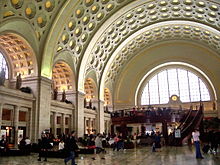 The grand, central interior of Union Station
The grand, central interior of Union Station
Today Union Station is again one of Washington’s busiest and best-known places, visited by 32 million people each year and has many shops, cafes and restaurants.
Passenger services include Amtrak’s high-speed Acela Express, Northeast Regional, and several of Amtrak’s long-distance sleeper trains (including, among others, the Capitol Limited,Crescent, Palmetto, and Silver Service trains); the MARC and VREcommuter railways, linking Washington to Maryland and Virginia, respectively; and the Washington Metro Red Line. From Union Station Amtrak also operates long-distance service to the southeast and midwest, including many intermediate stops to destinations like Chicago, Atlanta, New Orleans, and Miami. Over 13,000 passengers boarded or detrained Amtrak services daily in FY2011. It is also Amtrak’s busiest train station capable of handling Amtrak’s Superliner railcars.
The station is at the southern end of the Northeast Corridor, an electrified rail line extending north through major cities including Baltimore, Philadelphia,New York City, and Boston.
Amtrak Acela Express at Union Station (Upper Level)
The track area of the station is divided into upper and lower levels. The upper level contains tracks 1–20, which are served by high-level bay platforms at the door level of most trains. These tracks are used by all MARC commuter rail services on weekdays, all Amtrak Acela Express trains, and some Amtrak Northeast Regional trains that terminate at the station. All of the tracks on the upper level terminate at the station and are only used by trains arriving from and departing to the north.
The lower level contains tracks 22–29, which are served by low-level platforms at the track level. These platforms served by all VRE trains, all Amtrak long-distance trains that serve the station, and some Amtrak Northeast Regional trains that are continuing south to Virginia. Unlike the tracks on the upper level, the lower level tracks run through under the station building and Capitol Hill via the First Street tunnel. Electrification ends at the station, and all trains continuing south through the tunnel must have their electric engine swapped out for a diesel locomotive. For example, a southbound Northeast Regional train arrives on a lower level platform, on its way to Newport News, Virginia. Its EMD AEM-7 or HHP-8 engine is removed and set aside. A GE Genesis engine that was earlier removed from a northbound train is coupled to the front of the southbound, and it continues through the tunnel to Virginia. The electric engine is now placed on the northbound train, which then departs north towards Baltimore, Philadelphia, New York, and eventually Boston.
The D.C. Metrorail Red Line station is located underground beneath the western side of the building, and is the busiest station in the Metro system. The station exits to the street outside of the station, but also has direct access to the high-level Amtrak and MARC platforms.
Architecture
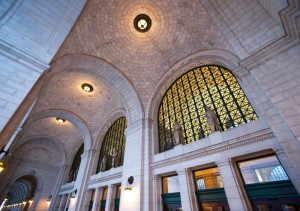 The grand, central interior of Union Station
The grand, central interior of Union Station
Architect Daniel H. Burnham, assisted by Pierce Anderson, was inspired by a number of different architectural styles. Classicalelements included the Arch of Constantine (exterior, main façade) and the great vaulted spaces of the Baths of Diocletian (interior); prominent siting at the intersection of two of Pierre L’Enfant’s avenues, with an orientation that faced the United States Capitol just five blocks away; a massive scale, including a façade stretching more than 600 feet and a waiting room ceiling 96 feet above the floor; stone inscriptions and allegorical sculpture in the Beaux-Arts style; expensive materials such as marble, gold leaf, and white granite from a previously unused quarry.
In the Attic block, above the main cornice of the central block, stand six colossal statues (modeled on the Dacian prisoners of the Arch of Constantine) designed by Louis St. Gaudens. These are entitled “The Progress of Railroading” and their iconography expresses the confident enthusiasm of the American Renaissance movement: Prometheus (for Fire),Thales (for Electricity), Themis (for Freedom and Justice), Apollo (for Imagination and Inspiration), Ceres (for Agriculture) and Archimedes (for Mechanics). The substitution of Agriculture for Commerce in a railroad station iconography vividly conveys the power of a specifically American lobbying bloc. St. Gaudens also created the 26 centurions for the station’s main hall.
Burnham drew upon a tradition, launched with the 1837 Euston railway station in London, of treating the entrance to a major terminal as a triumphal arch. He linked the monumental end pavilions with long arcades enclosing loggias in a long series of bays that were vaulted with the lightweight fireproof Guastavino tiles favored by American Beaux-Arts architects. The final aspect owed much to the Court of Heroes at the World’s Columbian Exposition of 1893 in Chicago, where Burnham had been coordinating architect. The setting of Union Station’s façade at the focus of converging avenues in a park-like green setting is one of the few executed achievements of the City Beautiful movement: elite city planning that was based on the “goosefoot” (patte d’oie) of formal garden plans made by Baroque designers such as André Le Nôtre.
The station held a full range of dining rooms and other services, including barber shops and a mortuary. Union Station was equipped with a presidential suite which is now occupied by a restaurant.
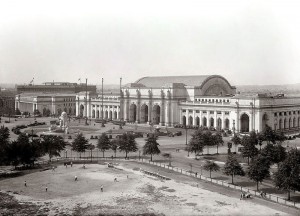 History – Predecessor terminals
History – Predecessor terminals
Prior to the opening of Union Station, each of the major railroads operated their own station: the Baltimore and Ohio Railroad trains arrived and departed from the New Jersey Avenue Station; the Baltimore and Potomac Railroad (a subsidiary of the Pennsylvania Railroad) operated from their own station at 6th and B Street, NW—the current location of the National Gallery of Art.
Opening and operation
When the Pennsylvania Railroad and the Baltimore and Ohio Railroad announced in 1901 that they planned to build a new union terminal, the city had two reasons to celebrate. The decision meant that both railroads would soon remove their trackwork and terminals from the National Mall. Though changes there appeared only gradually, the consolidation of the depots allowed the creation of the Mall as it appears today. Secondly, the plan to bring all the city’s railroads under one roof promised that Washington would finally have a station both large enough to handle large crowds and impressive enough to befit the city’s role as the federal capital.
Union Station opened on October 27, 1907, with the arrival of a Baltimore and Ohio Railroad passenger train from Pittsburgh. The terminal quickly became the portal to the Capitol. At no time was it busier than during World War II, when as many as 200,000 people passed through in a single day.
For most of its existence, Union Station served as a hub, with service of the Baltimore and Ohio Railroad, Pennsylvania Railroad, and Southern Railway. The Richmond, Fredericksburg & Potomac Railroad provided a link to Richmond, Virginia, about 100 miles to the south, where major north-south lines of the Atlantic Coast Line Railroad and Seaboard Air Line Railroad provided service to the Carolinas, Georgia, and Florida.
Decline – Further information: National Visitor Center
In 1967, the chairman of the Civil Service Commission expressed interest in using Union Station as a visitor center during the upcoming Bicentennial celebrations. Funding for this was collected over the next six years, and the reconstruction of the station included outfitting the Main Hall with a recessed pit to display a slide show presentation. This was officially the PAVE (Primary Audio-Visual Experience), but was sarcastically referred to as “the Pit.” The entire project was completed, save for the parking garage, and opening ceremonies were held on Independence Day 1976. Due to a lack of publicity and convenient parking, the National Visitor Center was never popular. Following a 1977 General Accounting Office report indicating Union Station was in danger of imminent structural collapse, the National Park Service closed the presentation in “the Pit” on October 28, 1978.
http://en.wikipedia.org/wiki/Union_Station_(Washington,_D.C.)

